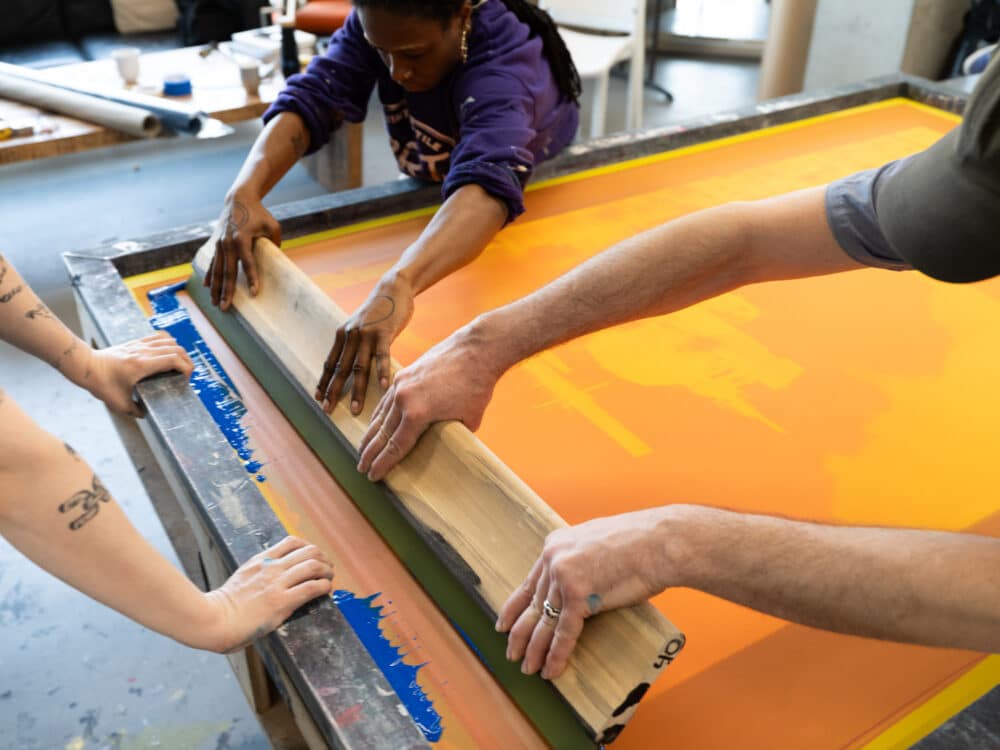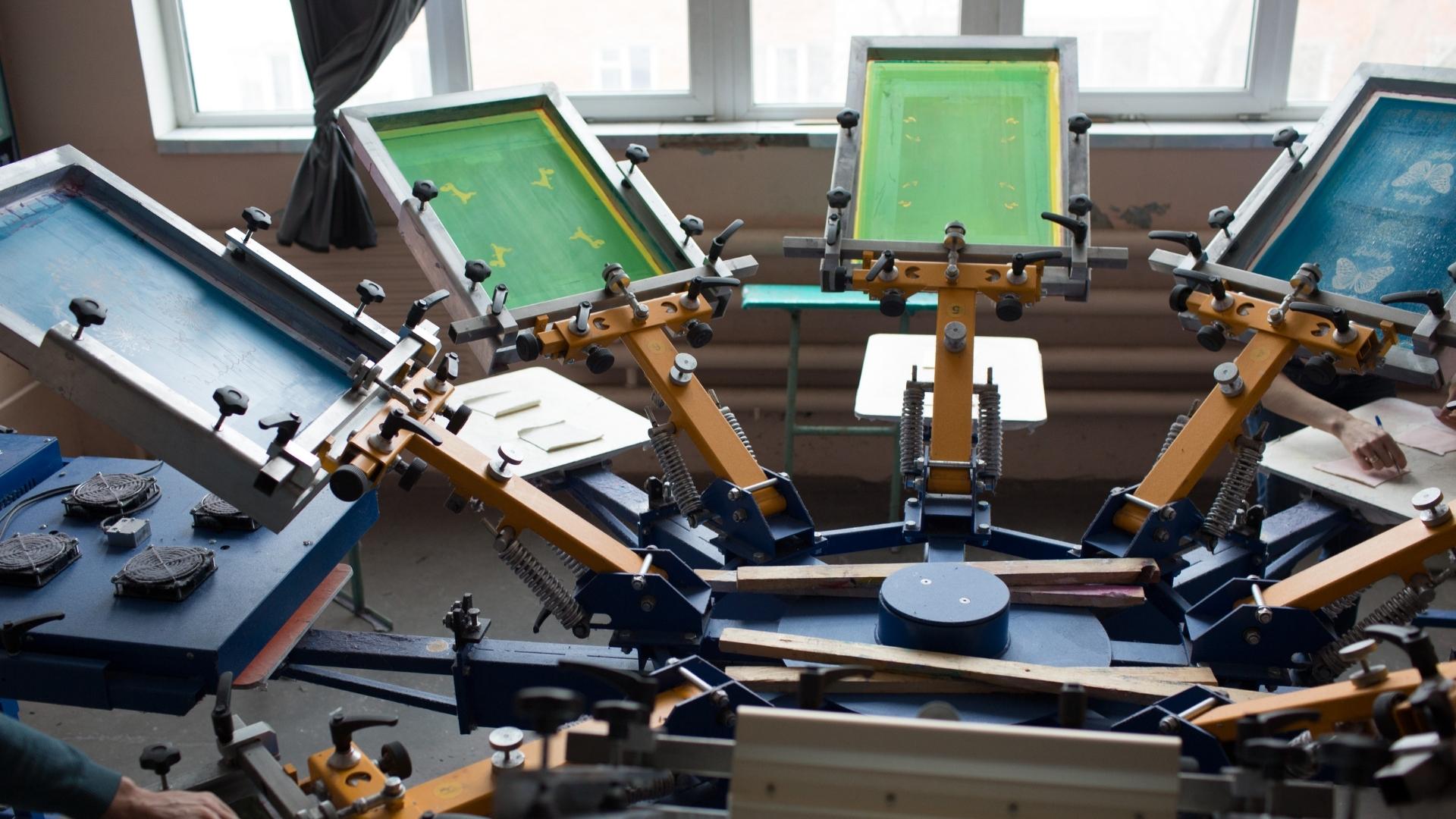Discover the Various Types of Screen Printing Techniques for Your Next Job
Screen printing provides a diverse variety of methods that can improve any kind of creative task. From conventional techniques like serigraphy to contemporary developments such as direct-to-garment printing, each strategy has its special advantages. Specialized choices, consisting of green and metallic inks, present much more possibilities. Comprehending these strategies can significantly affect the final result. The obstacle lies in picking the most suitable method for particular requirements and wanted impacts. What variables should one take into consideration?

The Fundamentals of Screen Printing
Although screen printing may appear facility, it is fundamentally a simple process that includes moving ink with a mesh screen onto various surface areas. The strategy begins with the production of a pattern, which defines the design to be printed. This pattern is affixed to a mesh screen, normally made from polyester or nylon. Once the pattern remains in place, ink is related to the screen and pressed via the mesh making use of a squeegee, leading to the wanted pattern being printed on the underlying product.
Screen printing can be done on a broad range of substratums, consisting of fabric, plastic, and paper, making it a flexible option for various projects. The procedure permits vivid colors and detailed layouts, making it prominent in industries such as art, fashion, and marketing. Recognizing these essentials equips people with the fundamental understanding required to explore even more advanced techniques in screen printing.
Traditional Screen Printing Techniques
Traditional screen printing strategies have actually been employed for centuries, maintaining the craftsmanship and virtuosity of this approach. This method utilizes a mesh screen to move ink onto a substratum, such as textile or paper, enabling dynamic and durable styles. The process starts with creating a stencil, which blocks certain locations of the screen to control where the ink will certainly be used.
One prominent strategy is serigraphy, commonly utilized for restricted versions and artistic prints. An additional is making use of water-based inks, which are eco-friendly and give a soft feeling on fabrics - 10:9 Design Screen Printing Texas. Furthermore, standard methods can consist of hand-operated printing, where artisans apply ink with a squeegee, making certain precision and interest to information
These methods continue to be valued in the sector for their responsive quality and the one-of-a-kind appearances they generate, attracting both creators and customers who appreciate the heritage of screen printing.
Digital Screen Printing Innovations
As the need for faster manufacturing and personalization in the printing industry has surged, digital screen printing innovations have arised as a game-changer. This technology mixes traditional screen printing methods with electronic procedures, permitting for rapid prototyping and intricate styles that were formerly hard to attain. One significant development is the intro of direct-to-garment (DTG) printing, which helps with top quality, full-color prints on various fabrics without the requirement for screens. Furthermore, innovations in ink formulas have actually caused green choices that keep lively colors while decreasing environmental impact. Using automated systems even more improves production, reducing labor costs and enhancing precision. These advancements not just deal with tiny batch orders and tailored layouts but also enable quicker turnaround times, making them suitable for services concentrated on meeting consumer demands in a fast-paced market. Digital screen printing, as a result, stands for an essential evolution in the domain of printing methods.
Specialized Screen Printing Methods
Discovering specialty screen printing approaches discloses a varied variety of techniques that push the boundaries of imagination and functionality in the printing sector. Among these, glow-in-the-dark inks offer an unique aesthetic effect, making designs come active in low-light problems. Metallic inks, known for their glittering finish, include a touch of high-end to published materials. One more ingenious method is discharge printing, which eliminates dye from the fabric as opposed to including ink, leading to a soft, vintage feeling. High-density printing produces a raised structure on the surface area, boosting responsive involvement. Additionally, water-based inks are gaining popularity for their vivid shades and reduced ecological influence. Each of these specialty techniques caters to certain design needs, making it possible for artists and brands to create standout products that resonate with their audiences. By leveraging these approaches, services can raise their screen printing jobs to new heights, ensuring remarkable perceptions.
Eco-Friendly Screen Printing Options
Environmentally friendly screen printing options are getting traction as the industry shifts in the direction of sustainability. Sustainable ink selections and the usage of naturally degradable products are vital elements in reducing the ecological effect of the printing procedure. By embracing these techniques, screen printers can contribute to a much more sustainable future while keeping high-quality results.
Sustainable Ink Options

Biodegradable Products Use
As the screen printing market advances, the consolidation of eco-friendly materials is ending up being increasingly vital for environmentally mindful techniques. Designers and producers are currently checking out inks and substratums made from natural, sustainable resources that disintegrate much more successfully than typical counterparts. These naturally degradable choices decrease plastic waste and decrease ecological impact, aligning with the expanding demand for sustainable products.
Common instances consist of water-based inks and natural cotton materials, both of which decrease unsafe chemicals and promote eco-friendliness. Brands that adopt these materials typically boost their market appeal, bring in customers that focus on sustainability. As awareness of environmental concerns remains to increase, the change in the direction of biodegradable products in screen printing is most likely to get energy, promoting a greener industry criterion.
Choosing the Right Technique for Your Job
Exactly how can one figure out one of check here the most ideal screen printing strategy for a certain task? The choice rests on a number of aspects, including the product to be printed on, the intricacy of the style, and the desired manufacturing quantity - 10:9 Design near me. Direct-to-garment printing is perfect for elaborate styles with countless colors, while typical screen printing succeeds for larger runs of easier graphics.
Additionally, consideration of the end-use of the printed product is vital. For outside applications, strategies that offer resilience and weather resistance, such as plastisol ink, may be chosen. Conversely, environmentally-conscious projects may gain from naturally degradable materials or water-based inks.
Eventually, recognizing the job's distinct demands enables for an enlightened option, ensuring both aesthetic appeal and functional longevity. By reviewing style complexity, material compatibility, and production scale, one can successfully pick one of the most suitable screen printing strategy to meet their task's goals.
Frequently Asked Inquiries
What Is the History of Screen Printing?
Screen printing came from in ancient China around 1000 AD, advancing via Japan and Europe. By the 20th century, it became prominent in business art and fashion, reinventing just how layouts were produced and dispersed globally.

How Do I Prepare Art Work for Screen Printing?
To prepare art work for screen printing, one need to ensure high resolution, make use of a suitable shade setting, produce different layers for each shade, and convert message to details, guaranteeing compatibility with the printing process and preferred end result.
What Products Are Best for Screen Printing?
The very best materials for screen printing include premium inks, long lasting displays, and ideal substratums like cotton, polyester, or blends. Additionally, using ideal emulsion and mops can enhance the printing procedure and outcomes.
Can I Screen Publish in your home?
Yes, screen printing at home is feasible. With the right products, configuration, and methods, individuals can create high-grade prints. Careful factor to consider of workspace and tools is vital for successful outcomes.
What Prevail Blunders in Screen Printing?
Common mistakes in screen printing consist of improper exposure times, insufficient ink uniformity, imbalance of displays, insufficient cleaning of materials, and disregarding to evaluate prints. These errors can compromise the top quality and precision of the final product.
Screen printing may appear complex, it is essentially a simple procedure that involves transferring ink via a mesh screen onto different surfaces. As the need for faster production and customization in the printing sector has actually risen, digital screen printing advancements have emerged as a game-changer. Discovering specialty screen printing techniques discloses a varied selection of techniques that press the borders of creative thinking and capability in the printing sector. The finest products for screen printing include high-grade inks, sturdy displays, and suitable substrates like cotton, polyester, or blends (10:9 Design near me). Usual blunders in screen printing consist of improper exposure times, insufficient ink consistency, misalignment of screens, not enough cleaning of materials, and ignoring to examine prints